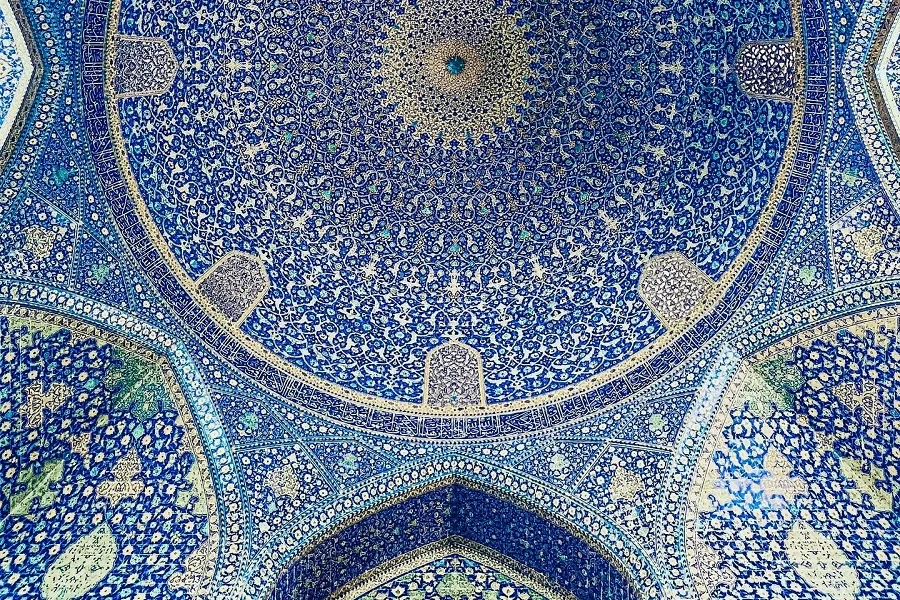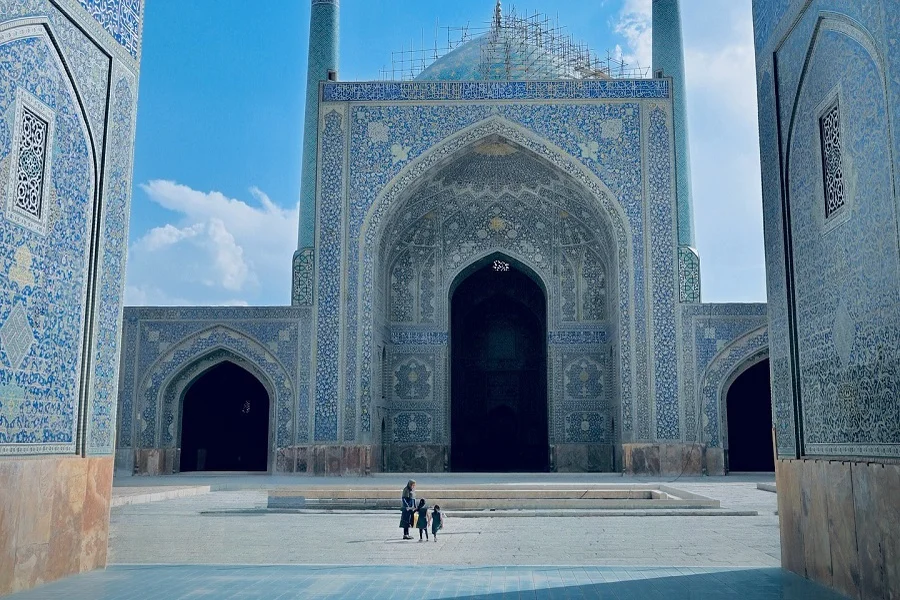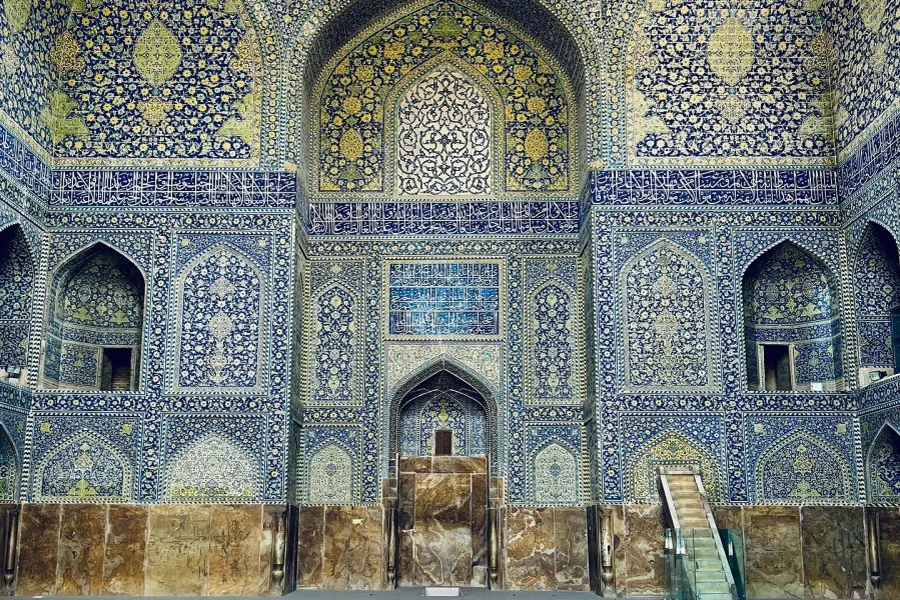
Shah Mosque
Isfahan, known as “Nesf-e Jahan” (Half of the World), boasts a rich history, and at its heart stands the stunning Shah Mosque (Masjid Imam). This iconic landmark represents the city’s beauty and cultural heritage. Visitors from across the globe come to admire its grandeur, and we’re here to share everything you need to know about it.
This guide covers everything you need to know about the Shah Mosque, including its fascinating history, stunning architecture, cultural significance, and essential visitor tips. Plus, we’ll highlight nearby attractions and experiences to help you fully enjoy your time in Isfahan.
History of the Shah Mosque
The Shah Mosque (Imam Mosque) carries a rich history intertwined with captivating stories and legends that enhance its charm. More than just an architectural masterpiece, it stands as a living testament to Isfahan’s enduring spirit and cultural heritage over the centuries.
The Shah Mosque (Masjed-e Emam) has witnessed Isfahan’s journey from a regional hub to a flourishing center of trade, culture, and art. Its story reflects the city’s growth and lasting importance in Iran’s rich heritage.
The Creators of the Shah Mosque
The Shah Mosque was commissioned by Shah Abbas I, a visionary ruler whose influence shaped Iran’s history. Renowned for his ambitious vision, he sought to transform Isfahan into one of the world’s most magnificent cities. By building the Shah Mosque, he intended to leave a lasting symbol of his reign and the grandeur of his empire.
Shah Abbas I was so dedicated to the Shah Mosque that he implemented a rule ensuring no building in Isfahan could surpass the height of its minarets. This regulation helped maintain the mosque’s commanding presence in the city’s skyline

The Construction Timeline of the Shah Mosque
Building the Shah Mosque was a monumental task that took around 18 years to complete. Throughout this period, the mosque underwent several stages of construction, with countless skilled architects and craftsmen contributing to its creation. The time and effort invested in this project highlight the remarkable dedication that went into making it an architectural masterpiece.
According to legend, hidden tunnels lie beneath the Shah Mosque, connecting it to other important landmarks in Isfahan. Though this remains a myth, it adds an intriguing layer of mystery to the mosque’s history, sparking curiosity among visitors.
The Architecture and Design of the Shah Mosque
The Shah Mosque stands as a true masterpiece of Iranian architecture, embodying the elegance of the Safavid style. Its design beautifully merges Persian and Central Asian architectural elements, resulting in a distinctive and breathtaking structure. With its expansive central courtyard, towering minarets, and grand dome, the mosque is a quintessential example of Persian architectural brilliance.
Key Architectural Features
As you tour the Shah Mosque, you’ll encounter several remarkable architectural features. The grand entrance portal, decorated with elaborate tilework and calligraphy, immediately captures attention. The towering minarets, each uniquely adorned with blue tiles, add a sense of majesty to the mosque’s overall splendor. The expansive central courtyard, encircled by a beautiful arcade of finely crafted columns and arches, offers a peaceful space for reflection and prayer.
Ornamental Features and Designs
What makes the Shah Mosque truly exceptional are its stunning decorative features and motifs. The mosque is embellished with a dazzling array of vibrant tiles, predominantly in blue and turquoise, showcasing the classic Persian style. Intricate floral and geometric patterns, paired with Quranic inscriptions, decorate both the interior and exterior, creating a mesmerizing display of light and color.
The geometric patterns and motifs on the tiles serve a purpose beyond their beauty. They were carefully crafted to assist worshipers in concentrating during prayer, as the repetition and symmetry of the designs offer a calming and meditative effect.

Building Materials and Construction Techniques
The Shah Mosque was built using a range of top-quality materials. Brick served as the main material for the walls and dome, which were then covered with intricately designed tiles. The iconic blue tiles, a hallmark of the mosque, were specially made for this purpose. The dome, an architectural wonder, features a double-shell design, with a gap between the layers for extra stability and insulation.
The Size of the Shah Mosque
The Shah Mosque occupies a vast space, with its central courtyard measuring roughly 70 meters by 40 meters. The majestic dome, soaring high above the mosque, rises to an astonishing height of approximately 53 meters (175 feet), making it a striking feature of the skyline. Flanking the dome are two towering minarets, each standing at around 48 meters (157 feet).
The spacious central courtyard can accommodate large groups of worshipers and also provides a peaceful area for reflection and socializing.
The Significance of the Shah Mosque
The Shah Mosque holds profound religious significance, serving as a place of worship and reflection for both the people of Isfahan and visitors from around the world. It is a hub for religious activities, including Friday prayers and important ceremonies. Its sacred atmosphere and breathtaking architecture foster a spiritual environment where worshipers can find peace and inspiration.
Politically, the Shah Mosque holds a significant place in the history of Isfahan and Iran. Built during the reign of Shah Abbas I, it marked the city’s rise as a powerful and influential capital of the Safavid Empire. The mosque’s strategic location and grand architecture were intentional, reflecting the political aspirations and vision of the Shah.
The Shah Mosque also played a key role in diplomacy during the 17th century. European envoys visiting Isfahan often held important meetings and negotiations within its walls, underscoring the mosque’s significance in the political landscape of the time.
Visitor Tips for Exploring the Shah Mosque
Shah Mosque Location and Address
The Shah Mosque is centrally located in Isfahan, ensuring easy access for visitors. You can find it at:
Naqsh-e Jahan Square, Isfahan, Iran

Ticket Price
There is an entrance fee to visit the Shah Mosque, which contributes to the preservation and maintenance of this historic site. Domestic visitors usually pay around 30,000 tomans, while foreign tourists typically pay about four euros. These fees are crucial in supporting the mosque’s ongoing conservation efforts.
Opening hours
The Shah Mosque generally follows regular visiting hours, though they may vary seasonally or during special events. It’s advisable to check the hours for each half of the year, as they can differ, particularly on Fridays, days of mourning, and during Itikaf.
Dress Code and Etiquette
While visiting the Shah Mosque, it’s essential to honor its deep religious and cultural importance. Here are some guidelines for dress code and behavior:
Dress respectfully: Both men and women are advised to wear attire that fully covers their arms and legs.
Remove your shoes: Before entering the prayer hall, you will need to remove your shoes as a sign of respect for the sacred space.
Maintain a respectful demeanor: Speak quietly and avoid loud conversations. The mosque is a place for contemplation and worship.
Best Times to Visit Shah Mosque
For an optimal experience at the Shah Mosque in Isfahan, consider visiting during the spring or fall. Additionally, these tips can help you plan the perfect visit:
Mornings: Early hours are typically quieter, providing a more peaceful and reflective atmosphere.
Weekdays: Weekdays are less crowded than weekends, making it easier to explore the mosque without the rush of locals and tourists.
Special occasions: Visiting during religious festivals or special events offers a unique cultural experience.

Guided Tours and Local Guides
Taking a guided tour can offer valuable insights into the Shah Mosque’s history, architecture, and cultural significance. Local guides are often passionate about sharing the rich stories and details of the mosque, deepening your appreciation of this iconic site.
To make the most of your visit, consider arranging a tour with one of our expert guides. Call us to book your tour in Isfahan and enjoy a more enriching experience!
Must-Sees Around Shah Mosque
While the Shah Mosque is undoubtedly a highlight of Isfahan, the area surrounding it is also filled with historical and cultural gems. Here are some nearby attractions worth exploring:
Naqsh-e Jahan Square: A UNESCO World Heritage Site and one of the largest squares in the world, Naqsh-e Jahan is surrounded by iconic buildings like the Ali Qapu Palace, Sheikh Lotfollah Mosque, and Qeysarie Gate. It’s a lively hub perfect for people-watching, shopping, and experiencing local culture.
Ali Qapu Palace: This six-story palace, located on the western side of Naqsh-e Jahan Square, is famous for its stunning music hall and an elevated terrace offering panoramic views of the square and Isfahan.
Sheikh Lotfollah Mosque: A masterpiece of Safavid architecture, this mosque features a delicate dome and breathtaking tilework. Its interior is a stunning array of color and design, showcasing the elegance of Persian craftsmanship.
Qeysarie Gate: The historic entrance to Isfahan’s Grand Bazaar, this gate is a blend of architectural beauty and commerce, offering visitors a chance to shop for traditional Iranian goods.
Chehel Sotoun Palace: Known as the “Forty Columns Palace,” this pavilion is set within a beautiful garden, featuring 20 slender wooden columns reflected in its tranquil pools.
Jolfa District: This historic Armenian quarter is famous for its unique architecture and the Vank Cathedral, known for its striking frescoes and cultural artifacts that offer a different perspective on Isfahan’s history.
Si-o-se-pol Bridge: Also known as the “Bridge of 33 Arches,” this picturesque bridge crosses the Zayandeh River and creates a mesmerizing reflection in the water, making it a favorite for photographers.
Restaurants and Cafes Around Shah Mosque
The area surrounding the Shah Mosque is home to many charming restaurants and tea houses that provide an authentic dining experience with Persian-style rugs and cushions. Here are some top spots to enjoy local cuisine:
Naghshe Jahan Traditional Restaurant: A classic spot offering delicious Persian dishes, with a cozy atmosphere perfect for enjoying traditional meals.
Shahrzad Restaurant: Known for its elegant setting and wide selection of flavorful Iranian dishes, this restaurant is a great choice for an upscale dining experience.
Miras Cafe Gallery: A unique blend of art and food, Miras Café offers a variety of tasty dishes along with an artistic ambiance.
Meydoon Café: A casual café offering light meals and snacks, ideal for a relaxing break after exploring the area.
Azadegan Tea House and Dizi Place: Famous for its traditional dizi (a Persian stew), this tea house serves a variety of Iranian beverages and comfort foods.

Recommendations for Local Cuisine
Joojeh Kebab: A must-try when in Isfahan, Joojeh Kebab features grilled chicken marinated in saffron and aromatic spices, offering a mouthwatering taste.
Biryani: Isfahan is renowned for its version of Biryani, a flavorful rice dish often paired with lamb, chicken, or vegetables and seasoned with saffron.
Gaz: For dessert, indulge in “Gaz,” a traditional Persian nougat made with rosewater and pistachios. It’s a sweet treat that captures the essence of Isfahan.
Fesenjan: For a unique experience, sample Fesenjan, a rich stew made with pomegranate paste, ground walnuts, and chicken, blending sweet and savory flavors in every bite.
Nearby Hotels and Guesthouses
Isfahan boasts a variety of accommodation options, with many hotels and guesthouses located close to the Shah Mosque (Masjed-e Emam). Here are some top recommendations:
Abbasi Hotel: A luxurious, historical hotel offering stunning Persian architecture and a memorable stay.
Kianpour Historical House: This charming guesthouse provides a unique experience, combining traditional Iranian design with modern amenities.
Ali Qapu Hotel: A conveniently located hotel with excellent service and comfortable rooms, perfect for those exploring the city.
Parsian Kowsar Hotel: A well-rated hotel offering a blend of comfort and convenience for travelers.
Isfahan also has several budget-friendly hostels, offering affordable accommodations with a social vibe for travelers looking to connect with others.
Last words
Visiting the Shah Mosque in Isfahan is an experience you won’t want to miss. This extraordinary site is a blend of history, culture, and architecture, offering a glimpse into the rich heritage of Isfahan and Iran. With its stunning beauty and deep historical importance, the Shah Mosque guarantees an unforgettable and enriching journey. Seize the opportunity to experience its grandeur firsthand!

